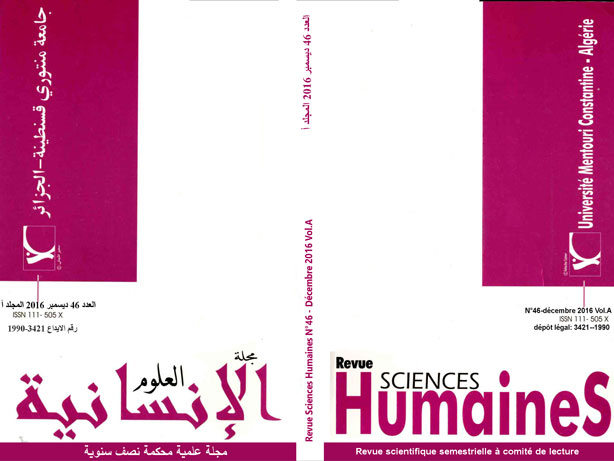Preemptive and Reactive Focus-on-Form Instruction: Effect on learning parallel grammatical structures
Keywords:
Instruction, focus on form, input enhancement, feedback, consciousness, raisingAbstract
The present study set out to investigate the differential effect of focus-on-form (FonF) instruction. Two research questions were raised: 1) Does FonF instruction,both preemptive and reactive, have a differential effect on learners' interlanguage? 2) Are short-term gains, if at all, maintained in the long-term? Fifty one (51) third-year LMD university English language learners are divided into two groups: a FonF group (N=27), and a Control group (N=24). Parallel structures were selected as the target form. A Grammaticality Judgment Test (GJT) was used to measure accuracy of the target form over the short- and the long-term; therefore, three similar but not identical tests were administered at three temporal times: a pre-test, an immediate post-test, and a delayed post-test. The results of the present study showed that FonF instruction had a differential effect in language learning in both the short- and the long-term. Recommendations for both research and pedagogy are discussed.
Downloads
References
Williams, J. Learner-generated attention to form. Language Learning:49/4. 1999, 583-625.
Long, M. Focus on form: A design feature in language teaching methodology. In K. deBot, C. Kramsch, & R. Ginsberg, (eds.), Foreign language research in cross-cultural perspective. Amsterdam: John Benjamin. 1991, 39-52.
Long, M., & Robinson, P. Focus on form: Theory, research and practice. In C. Doughty & J. Williams (eds.), Focus on form in classroom second language acquisition. Cambridge: CUP. 1998, 15-41.
Krashen, S.Principles and practice in second language acquisition. Oxford: Pergamon Press.1982.
White, L. Against comprehensible input: The Input Hypothesis and the development of second-language competence. Applied Linguistics:8/2. 1987, 95-110.
Larsen-Freeman, D. On the teaching and learning of grammar: Challenging the myths. In F. Eckman, D. Highland, L. P. J. Mileham, & R. Weber (eds.), Second language acquisition theory and pedagogy. Mahwah, NJ: Lawrence Erlbaum. 1995, 131–50.
Cadierno, T. Formal instruction from a processing perspective: An investigation into the Spanish past tense. Modern Language Journal: 79. 1995, 179–93.
Bardovi-Harlig, K.Tense and aspect in second language acquisition: Form, meaning, and use. Oxford: Blackwell. 2000.
Ellis, N. C. At the interface: Dynamic interactions of explicit and implicit language knowledge. Studies in Second Language Acquisition:27. 2005, 305–352.
Long, M. Does second language instruction make a difference? A review of the research. TESOL Quarterly:17/3. 1983, 359-382.
Ellis, R. Investigating form-focused instruction. Language Learning:51, supplement 1. 2001, 1-46.
Ellis, R. Does form-focused instruction affect the acquisition of implicit knowledge? A review of the research. Studies in Second Language Acquisition:24. 2002, 223-236.
Harley, B. Functional grammar in French immersion: A classroom experiment. Applied Linguistics:10/3. 1989, 331-359.
White, L. Adverb placement in second language acquisition: some effects of positive and negative evidence in the classroom. Second Language Research:7/2. 1991, 133-161.
Sharwood Smith, M. A. Input enhancement in instructed SLA. Studies in Second Language Acquisition:15/2. 1993, 165-179.
Schmidt, R. Awareness and second language acquisition. Annual Review of Applied Linguistics: 13/1. 1993, 206–226.
Long, M. Instructed interlanguage development. In L. M. Beebe (ed.), Issues in second language acquisition: Multiple perspectives. Cambridge, MA: Newbury House/Harper and Row.1988, 115–141
Spada, N. Form-focused instruction and second language acquisition: a review of classroom and laboratory research. Language Teaching: 30. 1997, 73-87.
Ellis, R., Basturkmen, H., &Loewen, S. Learner uptake in communicative ESL lessons. Language Learning: 51/2. 2001a, 281–318.
Long, M. The role of linguistic environment in second language acquisition. In W. C. Ritchie & T.K. Bhatia (eds.), Handbook of second language acquisition. New York: Academic Press.1996, 413-468
Swain, M. Communicative competence: some roles of comprehensible input and comprehensible output in its development’. In S. M. Gass and C. G. Madden (eds.), Input in Second Language Acquisition. Heinle and Heinle Publishers. 1985: 235-353.
Lightbown, P. M., &Spada, N. Focus-on-Form and corrective feedback in communicative language teaching. Studies in Second Language Acquisition: 12/4. 1990, 429-448.
Doughty, C. & Williams, J. Pedagogical choices in focus on form. In C. Doughty & J. Williams (eds.). Focus on form in classroom second language acquisition. Cambridge: CUP.1998.
Leow, R. P. Attention, awareness, and foreign language behavior. Language Learning: 51, supplement 1. 2001, 113-155.
Fotos, S. Integrating grammar instruction and communicative language use through grammar consciousness-raising tasks. TESOL Quarterly:28/2. 1994, 323-351.
Loewen, S. Variation in the frequency and characteristics of incidental focus on form. Language Teaching Research: 7/3. 2003, 315-345.
Williams, J. The effectiveness of spontaneous attention to form. System: 29/3. 2001, 325-340.
Ellis, R., Basturkmen, & H., Loewen, S. Doing Focus-on-Form. System: 30/4. 2002, 419-432.
DeKeyser, R. Beyond focus on form: Cognitive perspectives on learning and practicing in L2 grammar. In C. Doughty & J. Williams (eds.). Focus on form in classroom second language acquisition. Cambridge: CUP.1998.
Harley, B. The role of focus-on-form tasks in promoting child L2 acquisition. In C. Doughty & J. Williams (eds.). Focus on Form in Classroom Second Language Acquisition. Cambridge, England: Cambridge University Press. 1998, 156-174.
Lightbown, P. M. The importance of timing in focus on form. In C. Doughty & J. Williams (eds.). Focus on form in classroom second language acquisition. Cambridge: CUP.1998.
Spada, N. &Lightbown, P. M. Instruction and the development of questions in L2 classrooms. Studies in Second Language Acquisition: 15/2. 1993, 205–24.
Doughty, C. Second language instruction does make a difference: Evidence from an empirical study of ESL relativization. Studies in Second Language Acquisition: 13/4. 1991, 431-469.
Leeman, J., Arteagoitia, I., Fridman, B., & Doughty, C. Integrating attention to form with meaning: Focus on form in content-based Spanish instruction. In R. Schmidt (ed.), Attention and awareness in foreign language learning. Honolulu: University of Hawai‘i Press. 1995, 217–258
Doughty, C. & Varela,E. Communicative focus on form. In: C. Doughty & J. Williams (eds.). Focus on form in classroom m second language acquisition. Cambridge: CUP. 1998.
Day, E. M. &Shapson,S. M. Integrating formal and functional approaches to language teaching in French immersion: An experimental study. Language Learning:41/1. 1991, 25–58.
Bialystok, E. Psycholinguistic dimensions of second language proficiency. In W. Rutherford & M. A. Sharwood Smith (eds.). Grammar and second language teaching: A book of readings. New York: Newbury House. 1989, 31–50.
Bialystok, E. Explicit and implicit judgments of L2 grammaticality. Language Learning: 29. 1979, 81–103.
















